| Srl | Item |
| 1 |
ID:
133504
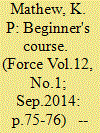

|
|
|
|
|
| Publication |
2014.
|
| Summary/Abstract |
I spent about a third of my three decade-long innings with the Indian Navy on training jobs. These included what was called Sub of the Gun or being the nursemaid to freshly inducted direct entry acting sub lieutenants on the training ship INS Cauvery, command of the cadet training ship INS Beas and Commandant of the Naval Academy at INS Mandovi. The primary task during the first two tenures listed was to make the trainees' experience the basics of seafaring on their first exposure to a ship and the sea, or provide them with their - 'sea legs' - in nautical parlance.
|
|
|
|
|
|
|
|
|
|
|
|
|
|
|
|
| 2 |
ID:
129955
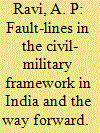

|
|
|
|
|
| Publication |
2014.
|
| Summary/Abstract |
The existing Higher Defence Management structure of India has been examined. The following inherent inadequacies have been identified:
a) Fault lines in the system including in the civilian military frame-work.
b) Lack of a unified management ethos.
c) An outdated military logistics management system.
d) Cadre management lacunae.
It has been concluded that adaptation of the 2011 British HDM model is best suited to meet the Indian contingency. The existing Indian Naval HDM structure has been used to develop a step by step process - taking forward the existing set up to achieve its final objective.
|
|
|
|
|
|
|
|
|
|
|
|
|
|
|
|
| 3 |
ID:
129365
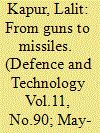

|
|
|
|
|
| Publication |
2012.
|
| Summary/Abstract |
Is an alumnus of the defence services staff college and the college of defence management, was directing staff at DSSC ad the college of naval warfare, Mumbai; has been the defence adviser at Muscat had held several important tri-service and naval appointment.
|
|
|
|
|
|
|
|
|
|
|
|
|
|
|
|
| 4 |
ID:
125979
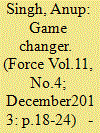

|
|
|
|
|
| Publication |
2013.
|
| Summary/Abstract |
The commissioning of the ex Gorshkov as INS Vikramaditya last month, was not just path breaking for the Indian Navy (IN) but more significantly for this important maritime nation. Many prophets of doom had predicted a 'dead bargain' and 'unrealistic time and cost overruns' as the forerunner of uncertainty for the future of naval aviation. They stand proven wrong.
Vikramaditya is not about keeping the art of carrier-aviation 'alive' for India (that was never in peril); nor was it a mere case of the current carrier being replaced. The 45,000 tonne Vikramaditya is about power projection, as against just air defence of the fleet, and, force projection that Light aircraft carriers are capable of. So, where are we and what does Vikramaditya bring with her? Well, we are somewhere there and she will surely be a game changer after a long, long time.
|
|
|
|
|
|
|
|
|
|
|
|
|
|
|
|
| 5 |
ID:
133010
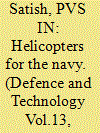

|
|
|
|
|
| Publication |
2014.
|
| Summary/Abstract |
Vrikrant (version1.0], INS Viraat and now, lNS Vikramaditya. In the last ' three decades, the carrier types have A changed, the fighter types and the fighters have changed but the Anti-Submarine Warfare (ASW) helicopters and the Search & Rescue (SAR) helicopters have remained the same. The prized aircraft carriers of the lndian Navy Viraat and Vikramaditya, share the meagre ASW helicopter resources represented in the INAS 330 Harpoons, a squadron that has been spiritedly operating the Westland Seaking Mk 42/42A and 42B. This isn't saying much because the 20 Seaking 42B's acquired in the mid-1980's (commencing 1985) now number less than 14 and are operating on will power, 'jugaad' and prayer, much to the dismay of all concerned.
|
|
|
|
|
|
|
|
|
|
|
|
|
|
|
|
| 6 |
ID:
126464
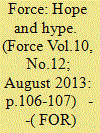

|
|
|
|
|
| Publication |
2012.
|
| Summary/Abstract |
St Petersburg: The Russian ship-building industry is in an interesting position vis-a-vis India, these days. It has unparalleled history of cooperation with the Indian services. It professes to extend support and technology that no other country can do. And it has been sanguine in the knowledge that the user (Indian Navy) and its political masters have a degree of comfort when it comes to their products and platforms.
|
|
|
|
|
|
|
|
|
|
|
|
|
|
|
|
| 7 |
ID:
131918
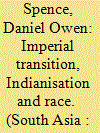

|
|
|
|
|
| Publication |
2014.
|
| Summary/Abstract |
This article examines the colonial legacies in the development of the Indian and Pakistani navies following Independence. As both navies struggled with problems of indigenising their forces, Britain endeavoured to maintain its regional hegemony by extending the professional dependency of both. The influence of imperial ideologies and racial discourses of power on these relationships and on Indian naval identity caused India's and Pakistan's navies to evolve in different directions, as did Cold War geopolitics and civil-military relations. By analysing the challenges faced by India in achieving strategic independence, this article widens existing debates surrounding the neo-colonialism of Indian governance and education during the Nehruvian period, the reinvigoration of Empire and the limits of British imperial power after World War II.
|
|
|
|
|
|
|
|
|
|
|
|
|
|
|
|
| 8 |
ID:
126688
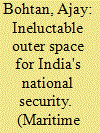

|
|
|
|
|
| Publication |
2013.
|
| Summary/Abstract |
Outer space, or simply space, is the void that exists between celestial bodies. This frontier of outer space is fast emerging as the fourth dimension (after land, sea and air) for military applications. Space will undoubtedly be the military high ground for warfare in the future acting as a "force multiplier" for any military operation. Militarization of space involves use of space technology for exploiting weapons on the ground and in the earth's atmosphere with more accuracy. India has to defend her physical, economic and cultural identity in the prevalent geo-political milieu as it faces varied and complex security challenges. There is a clear and present danger that sooner or later space could be weaponized by various countries. India can no longer be immune to the rapidly changing international security environment, threat to India's national security from nuclear and missile capabilities in its neighbourhood and the vulnerabilities of its space assets. It is therefore imperative that India exploits the capabilities of space, concurrently at appropriate levels, to achieve the desired operational capabilities in a compressed time frame. Since the early 1990s, the Indian armed forces have benefitted from the Indian Space Research Organisation (ISRO) civilian satellites. However, as operational requirements now demand an increase in military capabilities, the armed forces certainly need dedicated military satellites. This space capability has to be optimally exploited by the three services of the Indian defence forces with synergy and harmony, which is possible only under a single appropriate command structure. It is high time that India realizes: "To remain in Race, the Indian armed forces should be in Space".
|
|
|
|
|
|
|
|
|
|
|
|
|
|
|
|
| 9 |
ID:
133040
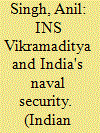

|
|
|
|
|
| Publication |
2014.
|
| Summary/Abstract |
'naval-vessel-building facilities are concerned, China and India are not at the same 'el. Over the past ten years, the People's Liberation Army Navy (PLAN) has built it') trigates and at least ten guided-missile destroyers, as well as advanced submarines. 'e weapons have been designed and made by China. On the other hand, India has Ilcl six destroyers and six trigates over the past ten years but currently only one ot those "in service.l0 Currently, the Indian Navy is seemingly relying on overseas purchases maintain its fleet in the future.
|
|
|
|
|
|
|
|
|
|
|
|
|
|
|
|
| 10 |
ID:
132810
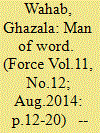

|
|
|
|
|
| Publication |
2014.
|
| Summary/Abstract |
Smile comes easily to Admiral Robin Dhowan. And it reaches his eyes just as quickly as it touches his lips, forcing his interlocutor to smile too. With ambience such as this, it requires super-human effort to veer the conversation towards any subject less than pleasant. How does one judge a person, or weigh his assertions if he smiles all the time and his eyes twinkle so often?
|
|
|
|
|
|
|
|
|
|
|
|
|
|
|
|
| 11 |
ID:
126149
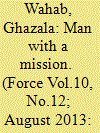

|
|
|
|
|
| Publication |
2013.
|
| Summary/Abstract |
First impressions are rarely accurate. But in the case of chief of naval staff, Admiral Devendra Kumar Joshi, the first impression held itself pretty accurately the second time too. The first time was at his annual press conference before the Navy Day last year when he took on the questions from the journalists without hesitation (some would say without caution as well), and the second time was at his house in the evening in the closing week of July.
|
|
|
|
|
|
|
|
|
|
|
|
|
|
|
|
| 12 |
ID:
129361
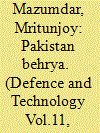

|
|
|
|
|
| Publication |
2012.
|
| Summary/Abstract |
Pakistan's navy (Pak Behrya) with an estimated strength of 25000+ personnel, is an medium size navy with a relatively well balanced fleet and naval air assets. On the one hand, the Pakistan Navy (PN) finds itself trying to counter an increasingly powerful Indian Navy (IN). on the other hand, it seeks to play a greater role in providing maritime security in Persian Gulf given that it sees itself as the eminent naval force in the middle east/ Persian gulf region. As a result it finds itself stretched to the limit.
|
|
|
|
|
|
|
|
|
|
|
|
|
|
|
|
| 13 |
ID:
125986
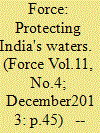

|
|
|
|
|
| Publication |
2013.
|
| Summary/Abstract |
Eurocopter's AS565 MB Panther provides a highly capable solution for planned helicopter acquisitions by the Indian Navy (IN) and Indian Coast Guard (ICG), offering a force multiplier with an excellent record that benefits from a heritage of mission-proven rotorcraft in service with military forces worldwide.
|
|
|
|
|
|
|
|
|
|
|
|
|
|
|
|
| 14 |
ID:
133493
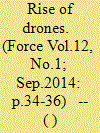

|
|
|
|
|
| Publication |
2014.
|
| Summary/Abstract |
The use of tactical unmanned aerial vehicles (UAVs) is increasing with growing threat perceptions. New UAVs are being used in operations and more advanced designs are on the drawing board. Although the Indian Air Force (IAF) uses several unmanned platforms for surveillance operations, it lacks the strength in tactical UAVs, especially when it comes to precision strike capabilities. For a long time, there was a proposal for the IAF to purchase Harop Loitering Munitions System from Israel Aerospace Industries (IAI). The proposal has been delayed for years now, and with the new government's dedication to speed up the slow pace of IAF modernisation, the procurement seems to be coming of age.
|
|
|
|
|
|
|
|
|
|
|
|
|
|
|
|
| 15 |
ID:
128613
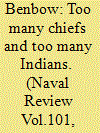

|
|
|
|
|
| Publication |
2013.
|
| Summary/Abstract |
The author draws on past experiences to establish some eternal verities of ship organization. Even the most recently joined officers will recognise at least some of these.
|
|
|
|
|
|
|
|
|
|
|
|
|
|
|
|
| 16 |
ID:
133498
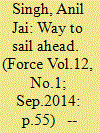

|
|
|
|
|
| Publication |
2014.
|
| Summary/Abstract |
The goal of achieving self-reliance in defence manufacture has got a renewed thrust with the recent enhancement in the FDI limit from 26 per cent to 49 per cent. That India has the unenviable distinction of being the biggest importer of military equipment in the world reflects poorly on a country that aspires to great power status. As a 'net security provider' in the Indian Ocean' it is also a core strategic vulnerability.
|
|
|
|
|
|
|
|
|
|
|
|
|
|
|
|
| 17 |
ID:
129340
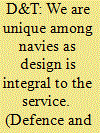

|
|
|
|
|
| Publication |
2012.
|
| Summary/Abstract |
D&T spoke to Rear Admiral KN Vaidyanathan, DG Naval Design , on current and future projects including stealth ships and the aircraft carrier, thrust areas in high technology and how the sees emerging international concepts like the in high technology and how he sees emerging international concepts like the global combat ship, Catamarans and Trimarans.
|
|
|
|
|
|
|
|
|
|
|
|
|
|
|
|
| 18 |
ID:
132257
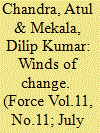

|
|
|
|
|
| Publication |
2014.
|
| Summary/Abstract |
Ensuring that delayed crucial aviation projects are delivered fast should be the new government's priority
Hope is riding high on the new Narendra Modi government. Little over a month after assuming the high office, India's Prime Minister has managed to boost the confidence of the Indian military forces. While symbolic gestures like spending a day aboard INS Vikramaditya helped to bring in motivation to the Indian Navy, which was plagued by series of accidents in the last few months; it is his policy decisions like opening up the defence industry to the private sector that has attracted foreign investors' confidence.
|
|
|
|
|
|
|
|
|
|
|
|
|
|
|
|